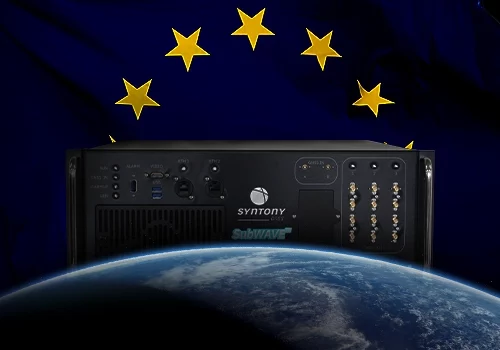A Leap Towards Advanced Precision and Scalability
The integration of the Galileo signals is not merely an addition of a new signal; it is a transformative change that has necessitated a complete overhaul of the SubWAVE system’s architecture. This rethinking has elevated the solution to an industrial scale, emphasizing scalability and ease of deployment. A notable enhancement in this upgrade is the redesign of the SubWAVE Simulator—the core component of the system. All connections have now been moved to the front face, significantly simplifying the installation process and making the system more user-friendly for on-site technicians.
Moreover, the computational power of the system has seen a threefold increase. This enhancement is not just about raw processing capabilities; it directly translates to a more robust simulation of signals and satellites, thereby extending the coverage range of a single simulator unit. This expansion capability directly correlates with cost efficiency, allowing for broader sections to be covered without the need for additional hardware.
Galileo: A Game-Changer for Underground GNSS Accuracy
The integration of Galileo signals into the SubWAVE system heralds a new era of precision and performance in underground GNSS solutions. The addition of Galileo, alongside the existing GPS signals, significantly enhances the system’s ability to provide accurate Position, Navigation, and Timing (PNT) information by leveraging a larger number of simulated satellites. This improvement in raw positioning is a direct result of the increased number of signals available for computation, ensuring better accuracy for standard GNSS receivers underground.
Moreover, the Galileo signals boast a superior signal dynamic range of 30dB, exceeding the 24dB offered by GPS signals. This superior dynamic range is pivotal for extending the coverage length within underground facilities when using Galileo signals. It also ensures better system compatibility with a broader spectrum of leaky feeders, which are integral to underground communication networks. As underground infrastructures grow in complexity, the scalable nature of this compatibility ensures that the SubWAVE system will continue to provide reliable and accurate GNSS signal simulations, tailored to the evolving needs of underground environments.
Streamlined Deployment and Enhanced Robustness
The new generation of SubWAVE simulators introduces significant advancements in deployment efficiency and system robustness. The simulator now features network piloting capabilities through a highly secured standard communication protocol, significantly streamlining the commissioning process. This progress allows the system’s configuration and testing via the “SubWAVE” Android mobile app, and enhances operational efficiency as well as deployment experience during calibration and setup phases. This capability also paves the way for future developments in auto-calibration, potentially enabling fully automated system setup in the near to medium term. These major improvements not only promise a reduction in installation times but also signify the solution’s evolution to industrial maturity.
Finally, the system’s robustness has been significantly enhanced. This robustness is crucial not only for the reliability of positioning data but also for the system’s longevity and maintenance requirements. By ensuring a high level of durability, the SubWAVE system sets the standard for underground GNSS solutions.
Future-Proofing with Multi-Constellation Support
In anticipation of future demands and technological advancements, the upgraded SubWAVE system has been designed with the flexibility to integrate additional satellite constellations such as BeiDou and QZSS. This forward-thinking approach ensures that the system is not just meeting the current needs of underground navigation but is also poised to adapt to the evolving landscape of global navigation satellite systems.
The integration of the Galileo constellation into Syntony’s SubWAVE system represents a significant leap forward in underground GNSS technology. With enhanced precision, scalability, and robustness, this upgrade sets a new benchmark in the field. As we look towards the future, the enhanced SubWAVE system not only promises to improve current underground navigation capabilities but also lays the groundwork for further innovations in global satellite navigation technology. Syntony GNSS remains at the forefront of this evolution, committed to delivering solutions that redefine the possibilities of underground positioning and navigation.
